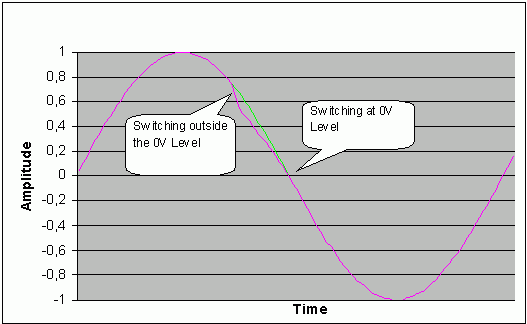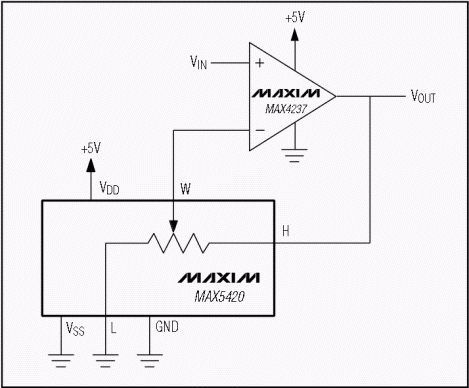Introduction The reliability of digital potentiometers is much higher than that of mechanical potentiometers, which can easily ensure more than 50,000 reliable reading and writing times, and the number of repeated adjustments of mechanical potentiometers can only reach thousands or even hundreds of times. The resolution of the digital potentiometer is 32 levels (5 bits) to 256 levels (8 bits) or higher. For applications with low dynamic range such as LCD contrast adjustment, select a device with a lower resolution to meet the actual application requirements. At present, some high-resolution digital potentiometers have become the ideal choice for high-fidelity applications such as audio, which can provide a dynamic adjustment range of up to 90dB.
Non-volatile applications require digital potentiometers to have non-volatile storage. Two types of devices (volatile and non-volatile memory) are popular on the market. The non-volatile digital potentiometer is closer to the mechanical potentiometer, it can maintain the resistance under different external conditions (whether there is an external power supply).
The audio device needs to store the volume setting internally. When the device is powered on again, it requires the potentiometer to maintain the same resistance value, even when the power is completely turned off.
The MAX5427 / MAX5428 / MAX5429 series of digital potentiometers provide unique programming functions. These devices have one-time programming (OTP) memory and set the power-on reset (POR) position of the potentiometer tap to a user-defined value (the tap position remains adjustable, but always returns to a fixed set position after power-on) . In addition, OTP can also prohibit interface communication and latch the tap to the required fixed position to avoid further adjustment. In this case, the device becomes a resistor divider with a fixed ratio, not a potentiometer.
The audio design considers that the potentiometer has a logarithmic tap and a linear tap. The volume adjustment of high-fidelity audio equipment generally uses a logarithmic potentiometer. Because of the nonlinear filtering characteristics of the human ear, the logarithmic tap can obtain a linear volume adjustment. Currently, highly integrated digital potentiometers can integrate six independent potentiometers in a single chip to support multi-channel audio systems, such as stereo and Dolby surround sound systems.
In audio applications, especially when the digital potentiometer adjustment resolution is low (32 levels), special attention needs to be paid to the change process between the tap levels. If the tap does not change at 0V, the audio system will produce clicks and pops (Figure 1). Fortunately, the new generation of digital potentiometers have a so-called zero-crossing detection function, which can reduce audio noise during tap transitions. Internal zero-crossing and timeout detection circuits ensure that the tap transitions after detecting a zero-crossing (0V) signal or after a 50ms delay (depending on the conditions that occur first).

Figure 1. The effect of audio clicks and pops when switching between 0V levels
In addition to the analog circuits in the digital potentiometers described above, each digital potentiometer also contains a digital interface. Most potentiometers can be programmed via traditional I²C or SPI ™, and some provide a convenient up / down adjustment interface.
Performance improvement Compared with mechanical potentiometers, digital potentiometers have another advantage. The adjustment tap of the digital potentiometer is directly installed in the signal path of the circuit board, and the electronic adjustment avoids the complicated and expensive mechanical adjustment device. The digital potentiometer improves the noise suppression index and eliminates the pickup noise of the mechanical potentiometer interface cable.
The traditional digital potentiometer can directly replace the mechanical potentiometer, and has the same working mode without too much explanation. However, in some special applications, such as low-cost stereo volume control, some additional instructions are required. For the special application of audio, it is generally required to work in a wider voltage range to support a wider audio signal range. Generally, logarithmic taps are selected. As the number of taps increases, the number of attenuation decibels increases, which is very suitable for the frequency response characteristics of the human ear. Some devices have a mute function to provide greater attenuation (for example: 30dB).
Temperature Consider one of the typical parameters of a digital potentiometer is the temperature coefficient (TC), defined in the rated temperature range. Most potentiometers need to define two different TCs. One is absolute end-to-end TC. This parameter represents the absolute value of the resistance change with temperature, which is calculated by the following formula:
ΔR = RUNCOMP × TC × ΔT / 106
among them:
RUNCOMP is the uncompensated resistance value,
TC is the temperature coefficient,
ΔT is the amount of temperature change.
For example, a digital potentiometer with a resistance of 20kΩ, if the absolute TC is 35ppm, then a resistance change of 35Ω (0.2%) will be generated within a temperature range of 50 ° C. In addition, the initial value of the end-to-end resistance of 20kΩ may change significantly, and the range of change may be 15kΩ to 25kΩ. In this case, for a 32-tap potentiometer, the corresponding resistance value (increment) of each stage may be 470Ω to 780Ω. This variation is much higher than the absolute TC deviation.
Another typical TC is the resistance ratio TC. The potentiometer is usually used as a voltage divider. Especially in proportional design, the requirements for the absolute resistance value change (absolute temperature coefficient) are not strict compared with the ratio change. For example, a ratio of 5 ppm TC can achieve a very stable gain over the entire temperature range.
When high-resolution digital potentiometers are used in programmable gain amplifiers (PGA) and instrumentation amplifiers (IA), the accuracy requirements are usually higher than standard adjustment circuits (Figure 2). These applications generally require a range of -40 ° C to + 85 ° C, and a voltage division ratio error (accuracy) within 0.025%.

Figure 2. Using an operational amplifier and a digital potentiometer (lower IC) to form a precision programmable gain amplifier
Conclusion Digital potentiometers have many advantages over mechanical potentiometers. In addition to improving reliability, they also occupy less space; due to reduced parasitic effects, digital potentiometers can provide better electrical characteristics and are less susceptible to noise. influences. Digital potentiometers can replace mechanical potentiometers in various applications, benefiting designers and end users.
Phlizon COB series Grow Light, best full Spectrum designed to perfectly match large areas of indoor plants, hydroponics horticulture agriculture, and greenhouse, especially for indoor Plant.
3000K 5000K Cree COB and Epistar dual-chip,most efficient spectrum,high PPFD.Instead of having dozens of small diodes, COB style Led Grow Lights typically only have a handful of huge COBs, each with strong lenses to direct the light down into the plant.The big aluminum heat sink to protect the grow lights from high temperature,good cooling,long lifespan.Photosynthesis and promote healthy growth budding and flowering.
These are rapidly gaining in popularity and are known for having deep penetration into the plant canopy. 1000w/1500w/2000w /2500w /3000w COB light, they will give you more options when your plants need different strength of illumination.
2500W COB LED Grow Light,Phlizon COB Grow Light,Phlizon Cree COB Grow Light,Full Spectrum Cree COB Grow Light
Shenzhen Phlizon Technology Co.,Ltd. , https://www.philizon.com